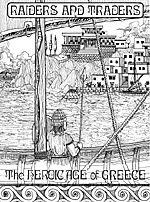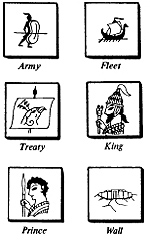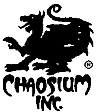 Introduction
Introduction
Raiders and Traders (RAT) was designed by Donald A. Dupont and published in 1979 by The Chaosium. This game focuses on competing civilizations of the Bronze Age (2900 - 1100 BC) in the Aegean Basin. This game is a good example of the empire-building subset of board wargames, with a good measure of Greek mythology thrown in.
Components
RAT, as was the case with most Chaosium products, was released only in ziploc bag form. Components are as follows:
1 big ziploc bag to hold everything
1 22”x34” area map of the Aegean Sea and the lands around it
1 16-page rules booklet with a silver-colored cover
2 sheets of 1/2” size diecut counters
2 cardstock sheets of play money and cards
 Counter Manifest
Counter Manifest
There are 300 counters with no blanks. All counters are blank and white on the reverse side.
Player Units (276 units total)
- 4 sets of 69 counters each: black on yellow; red; purple; and peach
Army 1x20; 5x9; 10x2 F leet 1x17; 5x7; 10x2
Treaty 5 Leaders king; queen; hero; prince x 2; princess x 2
Wall markers (24 total)
- 16 city walls (black on light blue)
8 Cyclopean city walls (black on white)
Cards
Money cards [in talents] (80 cards)
- 1 x 30; 5 x 20; 25 x 18; 100 x 10; 500 x 2
Fate cards (18 cards)
- Revolt x 5, Plague x 2, Drought x 2, Quake x 3, Good Fortune x 6 (Make Treaty x 1, Revenue 1x1 x2, Fertility x 1, Commerce +6 x 2)
Oracle cards (10 cards)
- -2 x 1; -1 x 2; 0 x 1; +1 x 3; +2 x 2; +3 x 1
| Deity Cards (12 cards) | ||||
|---|---|---|---|---|
| Deity (special power) | combat | fertility | commerce | revenue |
| Aprodite | 0 | +3 | +2 | x2 |
| Apollo (no plague) | +2 | +2 | +3 | x2 |
| Ares | +3 | 0 | +1 | 0 |
| Artemis | +1 | +1 | +2 | x2 |
| Athena | +3 | 0 | +3 | x2 |
| Demeter | 0 | +2 | +4 | x4 |
| Hephaestos | +1 | +1 | +6 | x2 |
| Hera (no drought) | +2 | +2 | +4 | x3 |
| Hermes | 0 | +1 | +6 | x1 |
| Hestia (no revolt) | 0 | +1 | +1 | x2 |
| Poseidon (no earthquake) | +2 | +2 | +5 | x1 |
| Zeus | +3 | +2 | +6 | x3 |
 Collector’s Value
Collector’s Value
Not many copies of any Chaosium game were made, and RAT is one of their more obscure titles. Boone quotes low, high and average prices of 13/20/16.50 at auction and 10/25/16.50 for sale. These prices are clearly a few years old and don’t reflect the inevitable effect of eBay. The copy used for this review was bought punched (certain components had also been lovingly laminated) for more money than the editor cares to divulge.
Player’s value
The game is for up to four players, and it can be played solitaire as well. There are three scenarios which are meant to be played in order, since additional units and concepts are added as you go (heroes, oracles, the Fates, pet deities, etc.) The rules are well written but are not numbered in the case system we are familiar with; instead the designer walks us through a game-turn, explaining concepts and procedures in the order you use them.
There is much familiar stuff here as empire-building type games go: there is a random first player, who then recruits armies and builds fleets and city walls and then takes them campaigning. There are some interesting twists in the combat system: there is no CRT per se, just a large amount of die roll modifiers applied to a single die roll, which yields a range of simple eliminated/exchange type results.
Following the “fight” is the “bite” -- players collect revenue from conquered provinces and from external trade. The trade system is rather odd in that profit or loss derives from a single die roll plus a massive die roll modifier equal to the total number of cities controlled and fleets used for mercantile purposes, but results are not linear.
Support Material
There is a section on Consimworld devoted to discussing “obscure multi-player games”, which is one place you’ll find mention of this game. “Lots of mythical and historical chrome, plus many random events. There is an interesting Fertility Rule ... Quasi-historical but quite faithful. Quite strategic (game turns in groups of generations, it seems), but not too long-playing.” --Richard Berg in S&T 76.
Other Games of this Type
The rise and fall of empires has always been a popular subject of both board and computer wargames, though there are no others that focus so specifically on the Myceneans.
Other ancient-themed empire building games include: IV Against Rome (3W); VI Caesars (Citadel); Civilization and Advanced Civilization (Avalon Hill); Alaric the Goth/Attila the Hun (SSG); Alexandros (XTR, Command 10); Ancient Conquest 1 & 2 (Excalibre); Attila, Scourge o’ God (XTR, Command 47); The Barbarians (Yaquinto); Barbarian, Kingdom and Empire (Icarus); Conquest (Quest Games); Cradle of Civilization (Historical Concepts); Decline and Fall (REG); Decline and Fall of the Roman Empire (Ariel); Empires of the Middle Ages (SPI); Fall of Rome (SPI, S&T 39 and Decision Games, S&T 181); History of the World (Avalon Hill); Imperator (3W); Imperium Romanum II (West End); Peloponnesian War (SimCan); Rise and Fall (Engelmann); Successors ( S&T 161)
Games with Greek gods and heroes appearing in them are less popular but here are some examples: Heroes of Olympus (Task Force Games); Iliad (Conflict/GDW); Iliad (International Team); Mythology (Yaquinto); Trojan War (Metagaming)
Other games by this Designer
Donald A. Dupont is an archaeologist and historian with an abiding interest in the Aegean Basin. The copy on the back cover of the rules booklet states that he was on numerous digs in the area. The only other game he published was Troy (self-published, 1977; Chaosium, 1978), well-received among collectors (and apparently trading for upwards of $100 on eBay, if that means anything).
Back to Simulacrum Vol. 3 No. 4 Table of Contents
Back to Simulacrum List of Issues
Back to MagWeb Master Magazine List
© Copyright 2001 by Steambubble Graphics
This article appears in MagWeb (Magazine Web) on the Internet World Wide Web. Other military history articles and gaming articles are available at http://www.magweb.com